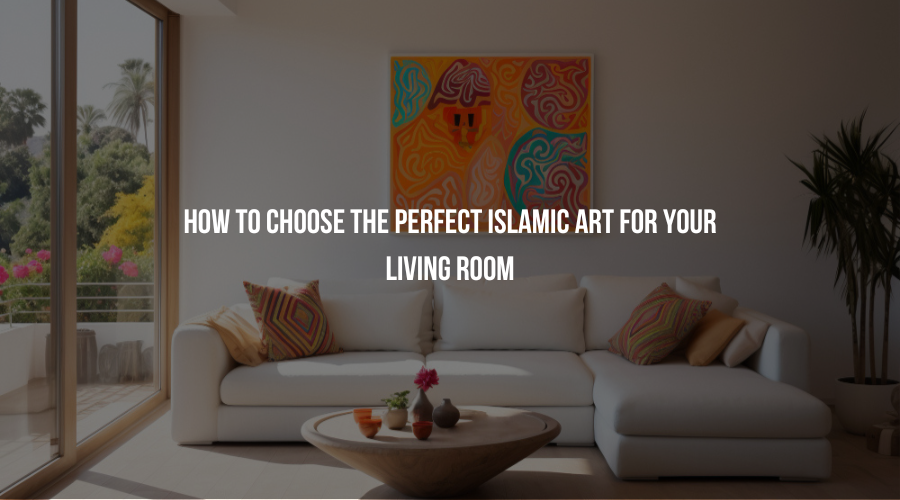Selecting the perfect Islamic art for your living room can transform the space into a serene and inspiring environment. Islamic decor, deeply rooted in the rich history and culture of Islam, adds a unique touch of elegance and spirituality to any home. Whether you are looking for pieces that reflect your faith or simply appreciate the beauty of Islamic art, this guide will help you choose the perfect items for your living room.
Understanding the Significance of Islamic Art
Islamic art is renowned for its intricate patterns, calligraphy, and symbolism. It often features verses from the Quran, geometric designs, and floral motifs. One of the most revered elements in Islamic decor is the Kaaba Kiswa, or Kaaba cover, which holds immense religious
Understanding the Significance of Islamic Art
Islamic art is renowned for its intricate patterns, calligraphy, and symbolism. It often features verses from the Quran, geometric designs, and floral motifs. One of the most revered elements in Islamic decor is the Kaaba Kiswa, or Kaaba cover, which holds immense religious significance. The Kiswa, the cloth that covers the Kaaba in Mecca, is adorned with Quranic verses and is a profound symbol of Islamic faith. Incorporating elements inspired by the Kiswa into your living room can bring a sense of spirituality and reverence to the space.
Choosing the Right Islamic Wall Art
When selecting Islamic wall art for your living room, consider the following tips to ensure you choose pieces that complement your space and resonate with your personal style.
1. Reflect on the Purpose
Before selecting any artwork, think about what you want the piece to achieve. Are you looking to create a focal point, add a spiritual touch, or simply enhance the aesthetic appeal of your living room? Understanding their purpose will help you in your selection process.
2. Embrace Calligraphy
Islamic calligraphy is one of the most popular art forms used in Islamic art. It often features verses from the Quran or famous Arabic quotes. Calligraphy pieces can be powerful and meaningful, adding a deep spiritual element to your living room. Look for pieces that resonate with you personally, whether it’s a favorite verse or a quote that inspires you.
3. Geometric Patterns and Arabesque
Geometric patterns and arabesque designs are quintessential in Muslim home decor. These patterns symbolize the infinite nature of Allah and are often used to create mesmerizing and intricate artworks. Geometric pieces can add a sophisticated and timeless look to your living room. Choose colors and designs that complement your existing decor.
4. Incorporate the Kaaba Kiswa
Incorporating elements inspired by the Kaaba Kiswa can bring a unique and reverent touch to your living room. While an actual Kiswa may be beyond reach, many artists create beautiful replicas or pieces inspired by the Kiswa’s design. These can serve as a spiritual centerpiece, reminding you of the holiness of the Kaaba and its significance in Islam.
Selecting the Right Size and Placement
The size and placement of your Islamic art are crucial to achieving the desired effect in your living room.
1. Consider the Space
Evaluate the wall properly where you plan to hang the wall art. A large, blank wall might benefit from a sizable piece of Islamic wall art, creating a bold statement. Conversely, a smaller wall or space between windows may be better suited for a series of smaller pieces.
2. Balance and Proportion
Ensure that the art is proportionate to the furniture and the overall size of the room. Oversized pieces can give a warm look to a small room, while tiny artworks might get lost on a large wall. Aim for balance and harmony in your arrangement.
3. Eye Level Placement
As a general rule, artwork should be hung at eye level for the average person. This ensures that the art is easily viewable and appreciated. If you are creating a gallery wall or a collection of pieces, start by positioning the central piece at eye level and work around it.
Integrating Islamic Art with Existing Decor
Successfully integrating Islamic art into your living room involves considering your current decor style and color scheme.
1. Complementary Colors
Choose artworks that complement your existing color palette. If your living room features neutral tones, vibrant Islamic art can add a pop of color. Conversely, if your decor is already colorful, consider more subdued and monochromatic pieces to maintain balance.
2. Harmonizing Styles
While Islamic decor is unique, it can harmonize with various interior styles. For a modern living room, opt for sleek, minimalist Islamic art. For a more traditional space, delicate and detailed pieces will blend perfectly. Mixing different styles can also create a dynamic and eclectic look.
3. Layering Textures
Incorporate a variety of textures through your Islamic decor. For instance, canvas paintings can be combined with metal wall art or wooden carvings. This layering of textures adds depth and interest to your living area.
Personalizing Your Space with Custom Islamic Art
Custom Islamic art allows you to create a truly unique and personal space. Consider commissioning a piece that holds special meaning for you and your family.
1. Family Crests and Names
Custom calligraphy featuring your family name or a family crest can be a meaningful addition to your living room. It personalizes the space and adds a unique touch that reflects your family’s identity.
2. Special Verses or Quotes
Commission a piece that includes a Quranic verse or an inspirational quote that holds personal significance. This can serve as a daily reminder of your faith and values.
Maintenance and Care
Proper maintenance ensures that your Islamic art remains beautiful and lasts for years.
1. Cleaning
Regularly dust your artwork using a soft cloth. For framed pieces with glass, use a gentle glass cleaner. Avoid using harsh chemicals that could damage wall art.
2. Avoiding Sunlight
Direct sunlight can damage your artwork over time. Place your pieces away from direct sunlight or use UV-protective glass for framed art.
3. Humidity Control
Excess humidity can damage artwork, particularly those made from wood or paper. Ensure your living room is well-ventilated and consider using a dehumidifier if necessary.
Conclusion
Choosing the perfect Islamic art for your living room involves thoughtful consideration of purpose, style, size, and placement. Whether you opt for intricate calligraphy, geometric patterns, or pieces inspired by the Kaaba Kiswa, each artwork can add a unique and spiritual dimension to your home. By integrating Islamic decor thoughtfully and maintaining it properly, you can create a beautiful, inspiring, and harmonious living space that reflects your faith and personal style.
Remember, the right piece of Islamic art not only enhances the aesthetic appeal of your living room but also serves as a constant reminder of your faith and the rich cultural heritage of Islam. Happy decorating!




